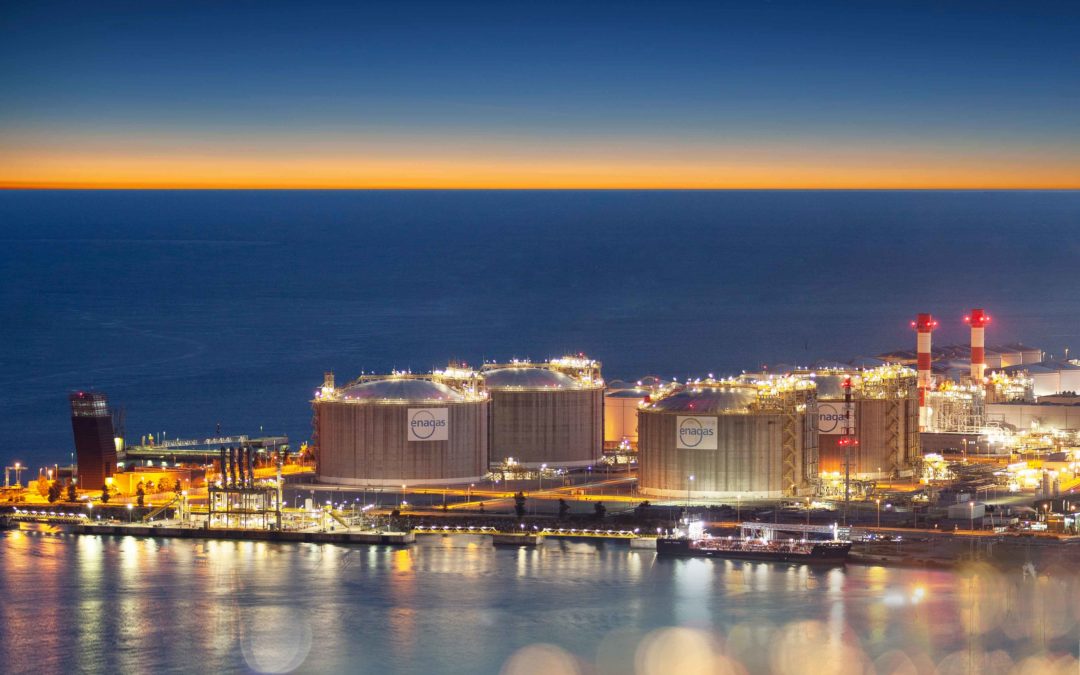In February 1969, the ship Aristotle, from Algeria, unloaded the first cargo of liquefied natural gas (LNG) to arrive on the Iberian Peninsula at the Regasification Plant in Barcelona.
We are celebrating the 50th anniversary of an important milestone in the history of energy in Spain: the arrival of natural gas in our country.
The Barcelona plant was not only Enagás’ first infrastructure, but was also the first regasification terminal in continental Europe, as I already mentioned in a previous post. Its construction, which was carried out between 1966 and 1968, was a major project and a real challenge due to tight deadlines, its pioneering character and the repercussions it would have on the country. It was necessary to carry out works in the port, constructing a protective dyke and dredging and filling an area behind the dyke to build an esplanade of about 220,000 m2. During the construction, innovative techniques were used such as pre-tensioned and post-tensioned concrete tanks; materials from the area were favoured, thereby promoting the development of the local economy; and in this phase a large team of workers of different nationalities was employed.
The terminal was put into operation in January 1969 and in April of the same year it began a regular supply of natural gas to industry in the Barcelona area, which was rapidly expanding at the time.
As a pioneering infrastructure in Europe, the Barcelona plant continues to be a benchmark for technology, security and innovation, and has been capable of adapting to new market needs. Today it celebrates 50 years in operation and is offering new logistics services, such as fuelling ships with natural gas (bunkering). It is also a prime example of energy efficiency. The plant’s success story is thanks to a team of highly qualified professionals, who are experts in energy and who have exceptional technical and human qualities.
The Barcelona Plant was the starting point for the Spanish Gas System as we know it today. The rest of the gas infrastructure was developed from this first LNG terminal, constituting a decisive step forward for Spain. It provided permanent access to the supply of natural gas and contributed to guaranteeing energy supply in general.
The history of natural gas in Spain is, therefore, relatively recent. The transition from city gas (gas manufactured from coal) to natural gas was fundamental to the country’s economic and industrial development. And it still is today: 60% of natural gas consumed in Spain is used by industries. It makes them competitive and provides them with the high calorific power that is essential for production.
As I have already explained on another occasion, it was Pere Duran Farell, with whom I worked at the beginning of my professional career, who was able to predict the role that natural gas was going to play in the economy and in society. He was the one who promoted its introduction in Spain.
This decision was also very important in terms of the environment. Today, the future is characterised by the energy transition and ambitious European and Spanish decarbonisation targets, to which natural gas and infrastructures such as the Barcelona plant are already contributing. In maritime transport, for example, LNG will continue to consolidate itself as the best alternative as a sustainable fuel, since it reduces CO2 emissions by 30% and also significantly improves air quality.
Making the most of the potential of the entire existing gas infrastructure network is a great advantage of another of the future energy vectors that Enagás is already promoting: renewable gases such as biogas/biomethane and green hydrogen. The latter could create a major disruption in the field of renewable energy storage.
With these challenges ahead, we are celebrating five decades of existence. The 50th anniversary of the arrival of natural gas at the Barcelona plant, our oldest facility and the origin of our company, is also the 50th anniversary of Enagás. We celebrate these anniversaries in 2019 while looking towards the future.
